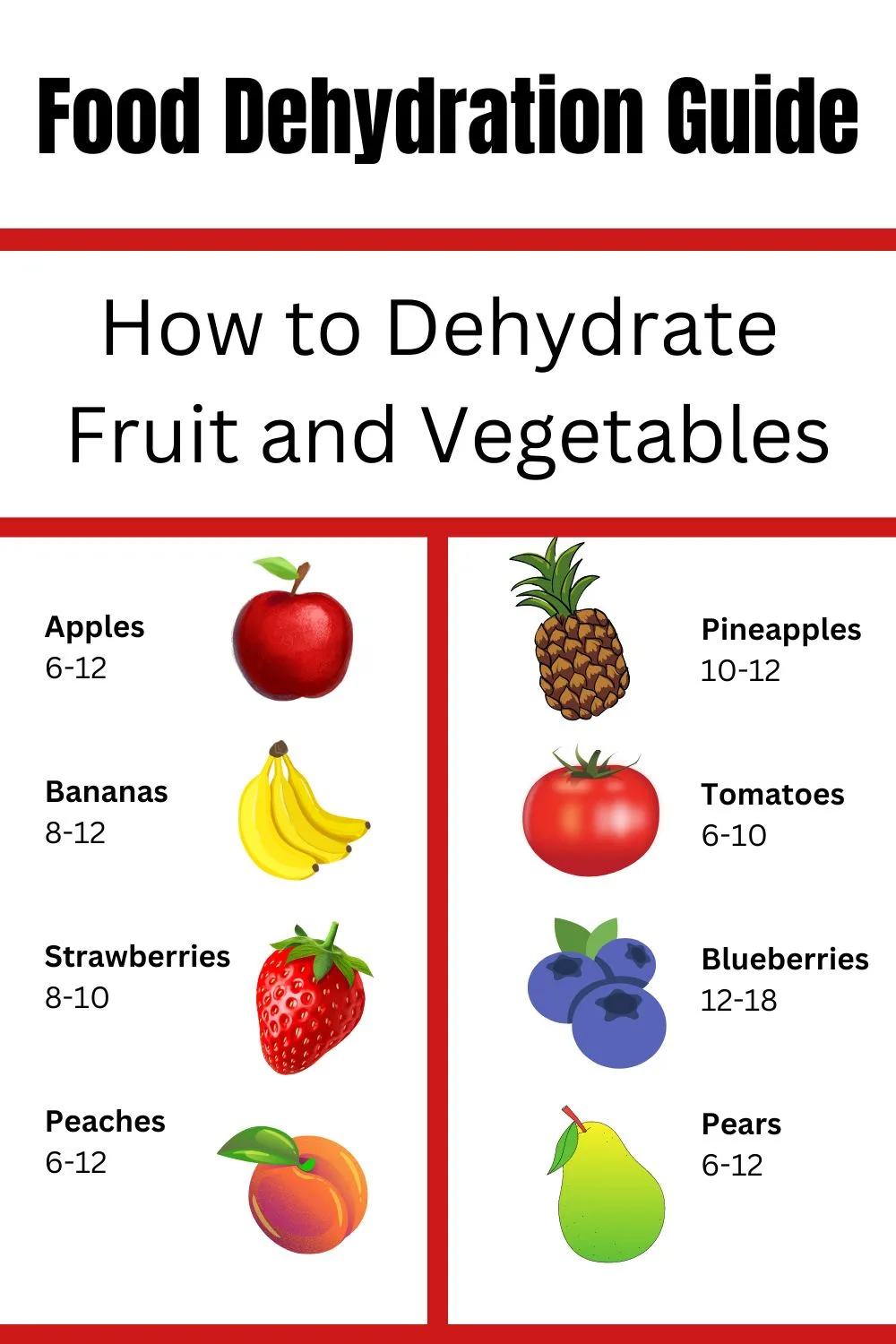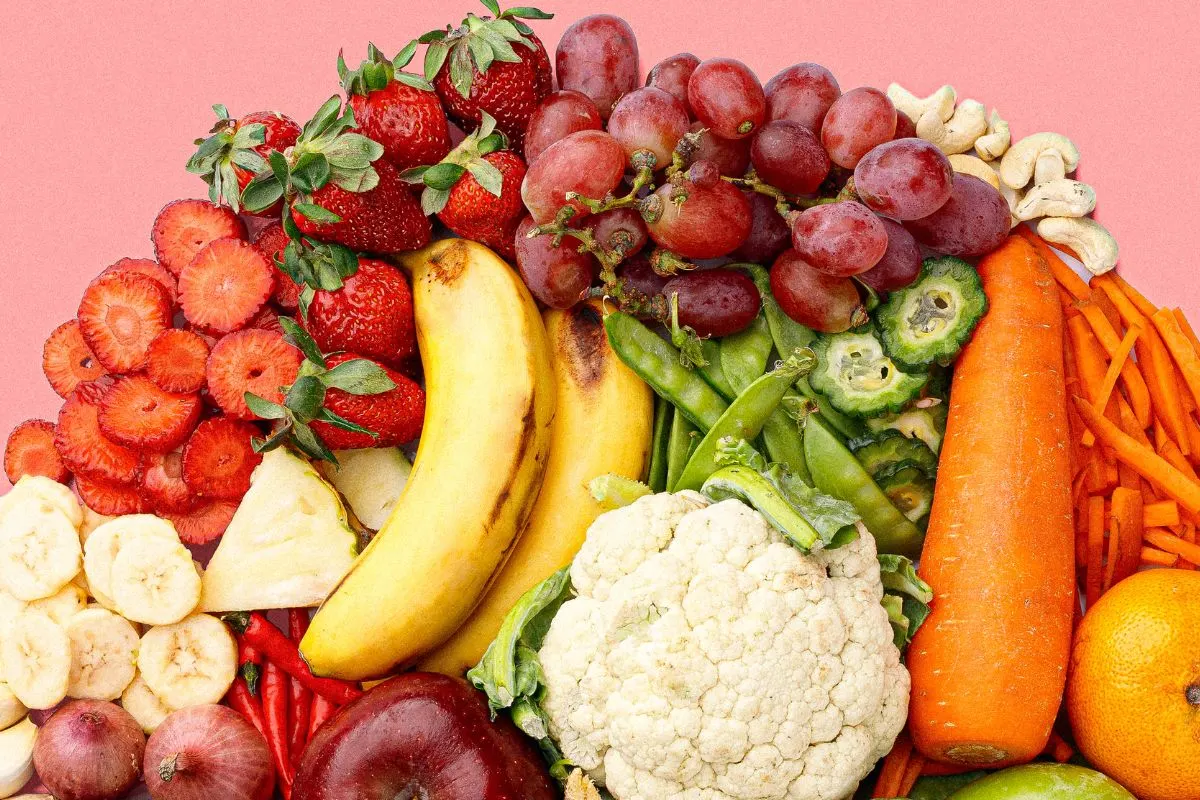Learning how to dehydrate fruit and vegetables is easier than you might think!
Dehydrating food is one of the oldest and most effective methods of food preservation, allowing you to enjoy your favorite fruits and vegetables year-round. By removing moisture from food, dehydration prevents the growth of microorganisms like mold and bacteria, resulting in a shelf-stable product that can last for years.
Whether you’re preparing for emergencies, looking to save money, or simply want to enjoy healthy snacks, this guide will walk you through the essentials of food dehydration.

This post contains affiliate links which means if you click a link, I will receive a small portion of the sale at no additional cost to you.
Why Dehydrate Fruit and Vegetables?
Dehydrating fruits and vegetables is an excellent way to extend their shelf life while retaining their nutritional value. When properly dehydrated, fruits can last up to 5 years, and vegetables can last between 8 to 10 years. This makes dehydration a perfect method for those who want to reduce food waste, preserve seasonal produce, or prepare for long-term storage.
Step 1: Choosing the Right Dehydrator
The first step in food dehydration is selecting the right equipment. There are several methods to dehydrate food, ranging from electric dehydrators to DIY solar dehydrators. Below are some options to consider:
Electric Dehydrators
Electric dehydrators are the most common and user-friendly option. The Excalibur 9 Tray Dehydrator is highly recommended for its even drying and large capacity. Unlike cheaper models, it distributes heat evenly, ensuring that your food dries consistently.
Air Fryer Dehydrators
To save space and keep food dehydrating easy, using an air fryer as a food dehydrator is a great option. It’s inexpensive, takes up less counter space and you can make a variety of foods using your air fryer as a dehydrator oven.
Solar Dehydrators
For those who prefer a more sustainable option, solar dehydrators like the All American Sun Oven are a great choice. These use the sun’s energy to dry food and can also double as an oven. They are perfect for those living in sunny climates or looking to reduce their carbon footprint.
Oven Dehydration
If you’re on a budget, you can use your kitchen oven as a dehydrator. Set your oven to the lowest possible temperature, ideally around 125°F. If your oven doesn’t go that low, you can crack the door open and use a fan to circulate the air. Keep in mind that this method may not be as efficient as a dedicated dehydrator and can be impractical during hot weather.
DIY Solar Dehydrators
For the more adventurous, building your own solar dehydrator is an option. This allows for customization based on your needs and available space. You can find numerous plans online, ranging from simple designs to more complex setups.
Step 2: Preparing Fruits and Vegetables for Dehydration
Preparation is key to successful dehydration. Here are the basic steps:
Washing and Cutting
Start by washing your fruits and vegetables thoroughly. Peel if necessary, and cut them into uniform pieces to ensure even drying. Removing pits, seeds, and cores is also important.
Blanching
Some fruits and vegetables require blanching before dehydration. Blanching involves briefly boiling the food, followed by plunging it into ice water to stop the cooking process. This step helps preserve color, texture, and nutritional value.
Fruits that require blanching
Apricots, cherries, grapes, plums, rhubarb.
Vegetables that may require blanching
Artichokes, asparagus, green beans, beets, broccoli, Brussels sprouts, cabbage, carrots, cauliflower, celery, collard greens, corn, fennel bulb, okra, parsnips, peas, potatoes, pumpkin, winter squash, sweet potatoes, Swiss chard.
How to Know When Food is Dehydrated
The key to perfectly dehydrated food is knowing when it’s done. Properly dehydrated food will be brittle or leathery, depending on the type. For instance, fruits like apples and strawberries should be pliable but not sticky, while vegetables like carrots and green beans should snap easily.
If you’re unsure, it’s better to over-dry than under-dry. Moisture left in the food can lead to mold growth during storage, so err on the side of caution.
Step 3: Storing Dehydrated Food
Proper storage is crucial to extending the shelf life of your dehydrated food. Here are some options:
- Short-Term Storage: For food you plan to use within a year, store it in airtight containers like mason jars. Keep these jars in a cool, dark place to protect the food from light and moisture.
- Long-Term Storage: For long-term storage (1-10 years), you’ll need to take extra precautions. Use airtight containers with oxygen absorbers, vacuum-sealed bags, or Mylar bags with oxygen absorbers. These methods remove any remaining air and protect your food from spoilage.
Be sure to check these dried fruit and vegetable storage safety instructions for additional information.
Step 4: Using Dehydrated Food
Dehydrated fruits and vegetables are incredibly versatile and can be used in a variety of dishes. Here’s how you can use them:
- Fruits: Dehydrated fruits can be enjoyed as snacks straight from the jar or rehydrated by soaking them in lukewarm water for about 15 minutes. They are perfect for baking, adding to cereals, or even blending into smoothies.
- Vegetables: Rehydrating vegetables is simple—just place them in a bowl, cover them with boiling water, and let them sit for 15 to 30 minutes. They can be added directly to soups, stews, and sauces without rehydrating. Dehydrated vegetables can also be used in casseroles, stir-fries, and more.
You Know How to Dehydrate Fruit and Vegetables, Now What?
- Experiment with Flavors: Before drying, consider seasoning your fruits and vegetables with herbs, spices, or a sprinkle of salt for added flavor.
- Monitor Temperature: Consistent low heat is key. Too high a temperature can cook the food instead of drying it, while too low can prolong drying time and potentially lead to spoilage.
- Label Your Jars: Always label your containers with the contents and the date they were dehydrated. This helps you keep track of freshness and ensures you use the oldest food first.

What fruits and vegetables are good to dehydrate?
Many fruits and vegetables are ideal for dehydration, including apples, pears, peaches, plums, apricots, bananas, cantaloupe, strawberries, blueberries, carrots, celery, corn, green beans, potatoes, and tomatoes. Additionally, fruits can be made into fruit leathers and rolls for a delicious snack.
How long do you leave fruit in a dehydrator?
Start your dehydrator right after loading it to begin the drying process. Although the drying time can vary, it typically ranges from 8 to 12 hours. Be sure to refer to your dehydrator’s manual for specific guidelines and monitor your fruits and vegetables as they near the end of the drying period to ensure they are properly dehydrated.
Should vegetables be cooked before dehydrating?
While many foods can be dehydrated at home, it’s generally recommended to cook most vegetables and meats before dehydrating them, unlike fruits. Cooking helps ensure safety and enhances the drying process. Once dried, these ingredients can be used to create a variety of meals.
What fruits cannot be dehydrated?
Most fruits dehydrate well, but avocados are an exception due to their high fat content, which can cause them to spoil quickly after drying. For long-term preservation, freeze-drying is a better option for avocados.
I have found that experimenting with different foods that people have told me not to dehydrate, came out the best. So once you learn how to dehydrate fruit and vegetables, start experimenting!
What are the disadvantages of dehydrating food?
Dehydrated foods can be calorie-dense and may contain high levels of sodium and sugars, depending on the type of food. Overconsumption of these nutrients can contribute to weight gain and increase the risk of health issues such as obesity, heart disease, and diabetes.
How to tell if dehydrated fruit is done?
Properly dehydrated fruits should be flexible and leathery. To test, remove a few pieces from the dehydrator and let them cool to room temperature. Squeeze the fruit between your fingers—if no moisture appears and the pieces spring back when released, the fruit is fully dried and ready for storage.
Dehydrating food is a fantastic way to preserve your harvest, reduce food waste, and create a stockpile of delicious, nutrient-dense snacks and ingredients. With the right equipment and techniques, you’ll be well on your way to mastering this age-old preservation method. If you have any questions or tips, feel free to leave a comment below—happy dehydrating!
If you have enjoyed this guide sharing how to dehydrate fruit and vegetables, please consider sharing on your favorite social media or signing up with your email so you never miss a post again.
Food Dehydrator Recipes
How to Use an Air Fryer as a Dehydrator & 9 Best Recipes
Homemade Dog Jerky Dehydrated Chicken Treats for Dogs
How to Make Beef Jerky with a Dehydrator
How to Make Air Fryer Apple Chips in 30 Minutes
About Thirty Something Super Mom

My journey started after a Crohn's disease diagnosis, inspiring a commitment to well-being. This site shares my distinctive approach to healthy living with my collection of nutritious recipes that boast authentic flavors, mimicking the indulgence of traditional dishes. I love sharing guilt free recipes for low carb, keto, gluten-free, paleo, and the specific carbohydrate diet. I also share tips on natural living, including homemade cleaners and cleaning hacks. I also share my experience as a veterinary technician and pet groomer, to integrate pet health tips, homemade dog food recipes, and grooming insights to ensure your pets thrive.
